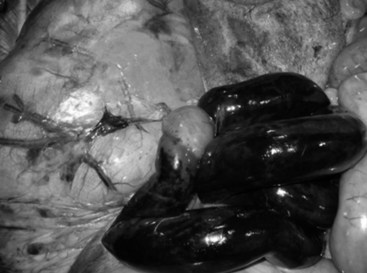Systemic Inflammatory Response Syndrome
Basic Information 
Definition
• The pathologic consequences of systemic inflammation in response to septic processes, severe trauma, endotoxemia or burns
• Consensus criteria for the systemic inflammatory response syndrome (SIRS) in equine patients are borrowed from human medicine, in which the systemic inflammatory response is manifested by two or more of the following: (1) hyperthermia; (2) tachycardia; (3) tachypnea or hypocapnia; and (4) leukogram changes, including leukopenia, leukocytosis, or an increased number of band or toxic neutrophils. When SIRS is induced by an infectious process, it is called sepsis.
Epidemiology
Species, Age, Sex
• In foals, SIRS and sepsis may be related to idiopathic bacterial septicemia, clostridial or salmonella enterocolitis, or rotacoccal pneumonia.
• In adults, SIRS and sepsis may be secondary to gastrointestinal disease (anterior enteritis, infectious colitis, strangulation) or pleuropneumonia, clostridial myositis, endometritis, peritonitis, or severe trauma (Figure 1).
• A pure form of SIRS may develop from the absorption of endotoxins, without an infectious nidus, in cases of surgical colic and colitis.
Clinical Presentation
Etiology and Pathophysiology
• An insult, whether it is infectious, traumatic, or inflammatory, initiates a proinflammatory and an antiinflammatory response. If these responses are appropriate and balanced, homeostasis is restored. If inflammation overwhelms the antiinflammatory processes and spills into the systemic system, SIRS develops, which may progress to end-organ dysfunction and MODS.
• Proinflammatory cytokines, including tumor necrosis factor, and interleukin-1, are released from activated macrophages. These cytokines amplify the inflammatory process through additional cytokines and enzymes that produce platelet activating factor, prostaglandin E2, leukotrienes, and nitrous oxide. Neutrophils are activated and marginate, inducing local tissue injury and destruction.
• The coagulation system also becomes dysregulated during SIRS, leading to inappropriate coagulation. The natural anticoagulation mechanisms, including activated protein C, tissue factor pathway inhibitor, and the heparin-antithrombin pathway, are also inhibited. These inhibitors of coagulation are important in preventing elevations in cytokine levels, neutralizing inflammatory mediators and minimizing endothelial cell dysfunction. Fibrinolysis is also impaired through the release of plasminogen activator inhibitor type 1.
Diagnosis 
< div class='tao-gold-member'>
Stay updated, free articles. Join our Telegram channel

Full access? Get Clinical Tree



